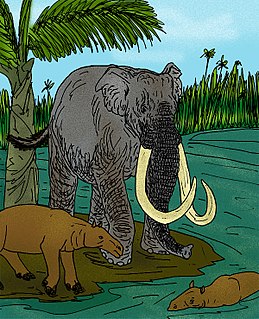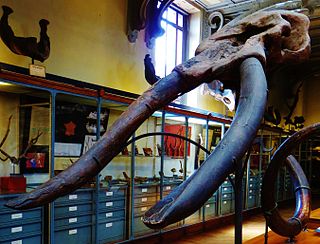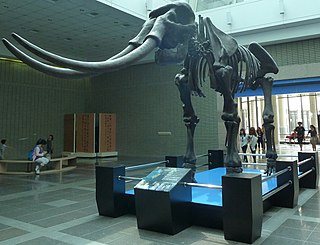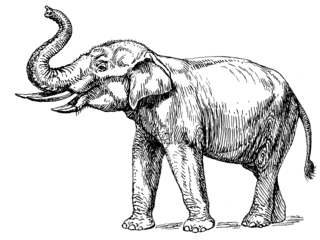 W
WThe African mammoth, Mammuthus africanavus, is the second oldest mammoth species, having first appeared around 3 million years ago during the late Pliocene, with a last appearance around 1.65 million years ago in the early Pleistocene. Its fossils have been found in Chad, Libya, Morocco and Tunisia. It was relatively small and is seen as the direct ancestor of M. meriodionalis, although its tusk diverged more widely from its skull than later species of mammoth, which might indicate that it was an evolutionary dead end.
 W
WAnancus is an extinct genus of elephantoid proboscidean native to Afro-Eurasia, that lived from the Tortonian stage of the late Miocene until the genus' extinction during the early Pleistocene, roughly from 8.5–2 million years ago.
 W
WCuvieronius is an extinct New World genus of gomphothere, named after the French naturalist Georges Cuvier. Alive, specimens typically stood about 2.3 m tall at the shoulder, weighed about 3.5 t and would have superficially resembled a modern elephant with spiral-shaped tusks.
 W
WDeinotherium was a large prehistoric relative of modern-day elephants that appeared in the Middle Miocene and survived until the Early Pleistocene. During that time, it changed very little. In life, it probably resembled modern elephants, except it had downward-curving tusks attached to the lower jaw.
 W
WElephas hysudricus is an extinct elephant species and was described from fossil remains found in the Siwalik hills. It lived during the Pliocene and Pleistocene epochs.
 W
WGomphotheres are any members of the diverse, extinct taxonomic family Gomphotheriidae. Gomphotheres were elephant-like proboscideans, but not belonging to the family Elephantidae. They were widespread in across Afro-Eurasia and North America during the Miocene and Pliocene epochs and dispersed into South America during the Pleistocene following the Great American Interchange. Gomphotheriidae in its broadest sense is probably paraphyletic with respect to Elephantidae, which contains modern elephants. While most famous forms such as Gomphotherium had long lower jaws with tusks, which is the ancestral condition for the group, after these forms became extinct, the surviving gomphotheres had short jaws with either vestigal or no lower tusks (brevirostrine), looking very similar to modern elephants, an example of parallel evolution. During the Pleistocene epoch, most gomphotheres became extinct, with the last two genera, Cuvieronius persisting in southern North America and Notiomastodon having a wide range over most of South America until the end of the Pleistocene and human arrival in the Americas around 11,000 years ago.
 W
WGomphotherium is an extinct genus of proboscids from the Neogene and early Pleistocene of Eurasia, Africa, North America and possibly also Asia.
 W
WLoxodonta atlantica is an extinct species of elephant in the genus Loxodonta, from Africa. It was larger than the modern African elephant, with more progressive dentition. It includes Pleistocene fossils from Ternifine, Middle Pleistocene fossils from Elandsfontein and Late Pliocene fossils from the Omo River, with a final dating in the Late Pleistocene. L. atlantica was said to probably derive from L. adaurora; however, an analysis in 2009 suggested that L. atlantica evolved from L. exoptata, and is ancestral to L. africana. The species is divided into two subspecies: L. atlantica atlantica and L. atlantica zulu. The type for Loxodonta atlantica is housed in the Muséum national d'histoire naturelle in Paris, but is listed without a specimen number.
 W
WA mastodon is any proboscidean belonging to the extinct genus Mammut that inhabited North and Central America during the late Miocene or late Pliocene up to their extinction at the end of the Pleistocene 10,000 to 11,000 years ago. Mastodons lived in herds and were predominantly forest-dwelling animals. They survived on a mixed diet and obtained food by browsing and grazing, somewhat similar to modern elephants, but probably with greater emphasis on browsing
 W
WNotiomastodon is an extinct proboscidean genus of gomphotheres endemic to South America from the Pleistocene to the Holocene. It was among the last known gomphotheres and one of two South American gomphotheres alongside Cuvieronius, and was the predominant gomphothere on the continent ranging widely over most of South America excluding the high Andes. The species has a long and convoluted taxonomic history due to its morphological variability and confusion with related gomphothere taxa, which was only resolved during the 2010s.
 W
WPalaeoloxodon is an extinct genus that contains the various species of straight-tusked elephants. The genus originated in Africa during the Pliocene era, and expanded into Eurasia during the Pleistocene era. One species, Palaeoloxodon namadicus, was possibly the largest known land mammal. The genus has a long and complex taxonomic history, and at various times, it has been considered to belong to Loxodonta or Elephas, but today is considered distinct.
 W
WPalaeoloxodon recki is an extinct species of elephant native to Africa during the Pliocene and Pleistocene. At up to 14 feet in shoulder height, it was one of the largest elephant species to have ever lived. It is believed that P. recki ranged throughout Africa between 3.5 and 1 million years ago. P. recki was a successful grass-eating elephant until it became extinct, perhaps by competition with members of the genus Loxodonta, the African elephants of today. Its descendant taxon, "Elephas" jolensis persisted into the late Middle Pleistocene, c. 205-130 kya in Kenya, after which it was replaced by Loxodonta africana after a severe drought period. P. recki is believed to be the ancestral species from which the Palaeoloxodon species of Eurasia are derived.
 W
WPrimelephas is a genus of Elephantinae that existed during the Miocene and Pliocene epochs. The name of the genus suggests 'first elephant'. These primitive elephantids are thought to be the common ancestor of Mammuthus, the mammoths, and the closely allied genera Elephas and Loxodonta, the Asian and African elephants, diverging some 4-6 million years ago. It had four tusks, which is unusual for an elephant. The type species, Primelephas gomphotheroides, was described by Vincent Maglio in 1970, with the specific epithet indicating the fossil specimens were gomphothere-like. Primelephas korotorensis is the only other species to be assigned to the genus.
 W
WRhynchotherium is an extinct genus of proboscidea endemic to North America and Central America during the Miocene through Pliocene from 13.650—3.6 Ma, living for approximately 10 million years.
 W
WSinomastodon is an extinct gomphothere genus, from the Late Miocene to the Early Pleistocene deposits of Asia. It is not to be confused with the genus Mammut from a different proboscidean family, whose members are commonly called "mastodons".
 W
WStegodon, meaning "roofed tooth" because of the distinctive ridges on the animal's molars, is a genus of the extinct subfamily Stegodontinae of the order Proboscidea. It was assigned to the family Elephantidae, but has also been placed in the Stegodontidae. Stegodonts were present from 11.6 million years ago (Mya) to the late Pleistocene, with unconfirmed records of localized survival until 4,100 years ago. Fossils are found in Asian and African strata dating from the late Miocene; during the Pleistocene, they lived across large parts of Asia and East and Central Africa, and in Wallacea as far east as Timor.
 W
WStegolophodon is an extinct genus of stegodontid proboscideans, with two tusks and a trunk. It lived during the Miocene and Pliocene epochs, and may have evolved into Stegodon. Fossils have been primarily found in Asia, but some have also been reported in Africa.
 W
WStegomastodon is an extinct genus of gomphotheres, a family of proboscideans. It ranged throughout North America from the early Blancan ~4 Ma, to the early Irvingtonian. The South American species have been synonymized with Notiomastodon platensis.
 W
WTetralophodon is an extinct proboscidean genus belonging to the superfamily Elephantoidea.
 W
WZygolophodon is an extinct genus of African, Asian, and European mammutid that lived from the Miocene to the Late Pliocene.